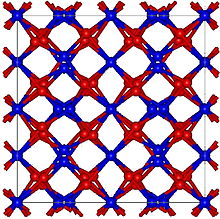സിങ്ക് നൈട്രൈഡ്

| |
| Identifiers | |
|---|---|
3D model (JSmol)
|
|
| ECHA InfoCard | 100.013.826 |
| EC Number |
|
PubChem CID
|
|
| UNII | |
CompTox Dashboard (EPA)
|
|
| InChI | |
| SMILES | |
| Properties | |
| Zn3N2 | |
| Molar mass | 224.154 g/mol |
| Appearance | blue-gray cubic crystals[1] |
| സാന്ദ്രത | 6.22 g/cm³, solid[1] |
| ദ്രവണാങ്കം | |
| insoluble, reacts | |
| Structure | |
| Cubic, cI80 | |
| Ia-3, No. 206 | |
| Hazards | |
| GHS labelling: | |

| |
| Warning | |
| H315, H319 | |
| P264, P280, P302+P352, P305+P351+P338, P321, P332+P313, P337+P313, P362 | |
| NFPA 704 (fire diamond) | |
Except where otherwise noted, data are given for materials in their standard state (at 25 °C [77 °F], 100 kPa).
| |
സിങ്ക് നൈട്രൈഡ് ( Zn3N2 ) സിങ്കിന്റെയും നൈട്രജന്റെയും ഒരു അജൈവ സംയുക്തമാണ്. ഇത് സാധാരണയായി (നീല) ഗ്രേ ക്രിസ്റ്റലുകളായി ലഭിക്കും. ഇത് ഒരു അർദ്ധചാലകമാണ്. ശുദ്ധമായ രൂപത്തിൽ, ഇതിന് ആന്റി- ബിക്സ്ബൈറ്റ് ഘടനയുണ്ട്.
രാസ ഗുണങ്ങൾ
[തിരുത്തുക]200 ഡിഗ്രിയിൽ കൂടുതലുള്ള താപനിലയിൽ, വായുരഹിതമായ അന്തരീക്ഷത്തിൽ സിങ്കാമൈഡ് (സിങ്ക് ഡയമൈൻ) Roscoe, H. E.; Schorlemmer, C. (1907) [1878]. A Treatise on Chemistry: Volume II, The Metals (4th ed.). London: Macmillan. pp. 650–651. Retrieved 2007-11-01.</ref> വിഘടിപ്പിച്ചുകൊണ്ട് സിങ്ക് നൈട്രൈഡ് ഉൽപ്പാദിപ്പിക്കാം. പ്രതികരണത്തിന്റെ ഉപോൽപ്പന്നം അമോണിയയാണ് . Bloxam, C. L. (1903). Chemistry, Inorganic and Organic (9th ed.). Philadelphia: P. Blakiston's Son & Co. p. 380. Retrieved 2007-10-31.</ref>
അമോണിയയിൽ സിങ്ക് 600 ഡിഗ്രി ° C വരെ ചൂടാക്കിയും ഇതുൽപ്പാദിപ്പിക്കാം. ഇതിലെ ഉപോൽപ്പന്നം ഹൈഡ്രജൻ വാതകമാണ് . [2] [3]
ഒരേ താപനിലയിലെ മൂലകങ്ങളിലേക്ക് സിങ്ക് നൈട്രൈഡിന്റെ വിഘടനം ഒരു മത്സര പ്രതികരണമാണ്. [4] 700 ഡിഗ്രി സെന്റിഗ്രേഡിൽ സിങ്ക് നൈട്രൈഡ് വിഘടിക്കുന്നു. [1] ഒരു നൈട്രജൻ അന്തരീക്ഷത്തിൽ സിങ്ക് ഇലക്ട്രോഡുകൾക്കിടയിൽ ഒരു വൈദ്യുത ഡിസ്ചാർജ് ഉൽപാദിപ്പിച്ചും ഇത് നിർമ്മിച്ചിക്കാം. [5] [6]
സിങ്ക് നൈട്രൈഡ് ജലവുമായി അക്രമാസക്തമായി പ്രതിപ്രവർത്തിച്ച് അമോണിയയും സിങ്ക് ഓക്സൈഡും ഉണ്ടാക്കുന്നു . [2] [7]
സിങ്ക് നൈട്രൈഡ് ലിഥിയവുമായി (ഒരു ഇലക്ട്രോകെമിക്കൽ സെല്ലിൽ ഉൽപാദിപ്പിക്കപ്പെടുന്നു) പ്രതിപ്രവർത്തിക്കുന്നു. [8] [9]
ഇതും കാണുക
[തിരുത്തുക]- നൈട്രൈഡ്
- സിങ്ക് നൈട്രേറ്റ്
അവലംബം
[തിരുത്തുക]- ↑ 1.0 1.1 1.2 1.3 CRC Handbook of Chemistry and Physics (96 ed.), §4-100 Physical Constants of Inorganic Compounds
- ↑ 2.0 2.1 Roscoe, H. E.; Schorlemmer, C. (1907) [1878]. A Treatise on Chemistry: Volume II, The Metals (4th ed.). London: Macmillan. pp. 650–651. Retrieved 2007-11-01.Roscoe, H. E.; Schorlemmer, C. (1907) [1878]. A Treatise on Chemistry: Volume II, The Metals (4th ed.). London: Macmillan. pp. 650–651. Retrieved 2007-11-01.
- ↑ Lowry, M. T. (1922). Inorganic Chemistry. Macmillan. p. 872. Retrieved 2007-11-01.
- ↑ Maxtead, E.B. (1921), Ammonia and the Nitrides, pp. =69–20
{{citation}}: CS1 maint: extra punctuation (link) - ↑ Mellor, J.W. (1964), A Comprehensive Treatise on Inorganic and Theoretical Chemistry, vol. 8, Part 1, pp. 160–161
- ↑ Maile, E.; Fischer, R. A. (Oct 2005), "MOCVD of the Cubic Zinc Nitride Phase, Zn3N2, Using Zn[N(SiMe3)2]2 and Ammonia as Precursors", Chemical Vapor Deposition, vol. 11, no. 10, pp. 409–414, doi:10.1002/cvde.200506383
- ↑ Bloxam, C. L. (1903). Chemistry, Inorganic and Organic (9th ed.). Philadelphia: P. Blakiston's Son & Co. p. 380. Retrieved 2007-10-31.Bloxam, C. L. (1903). Chemistry, Inorganic and Organic (9th ed.). Philadelphia: P. Blakiston's Son & Co. p. 380. Retrieved 2007-10-31.
- ↑ Amatucci, G. G.; Pereira, N. (2004). "Nitride and Silicide Negative Electrodes". In Nazri, G.-A.; Pistoia, G. (eds.). Lithium Batteries: Science and Technology. Kluwer Academic Publishers. p. 256. ISBN 978-1-4020-7628-2. Retrieved 2007-11-01.
- ↑ Pereiraa, N.; Klein, L.C.; Amatuccia, G.G. (2002), "The Electrochemistry of Zn3 N 2 and LiZnN - A Lithium Reaction Mechanism for Metal Nitride Electrodes", Journal of the Electrochemical Society, vol. 149, no. 3, pp. A262, doi:10.1149/1.1446079

